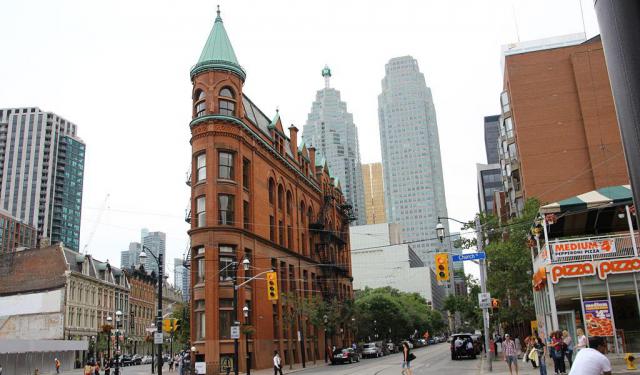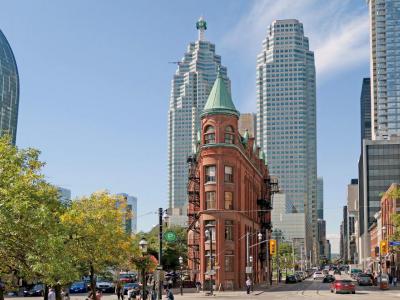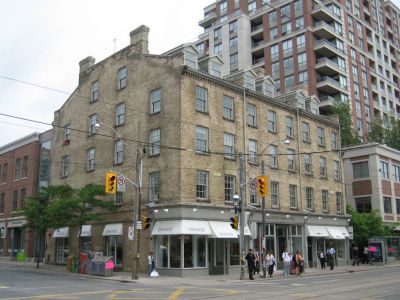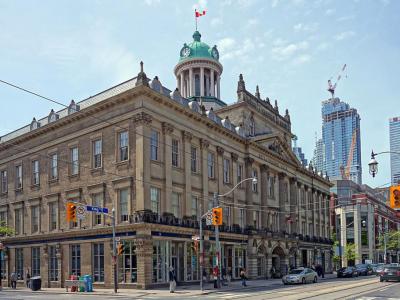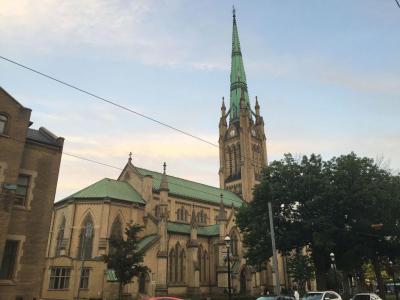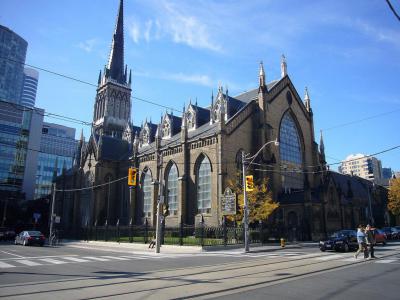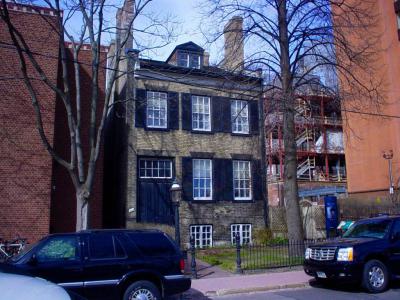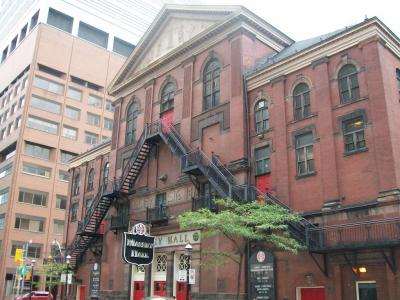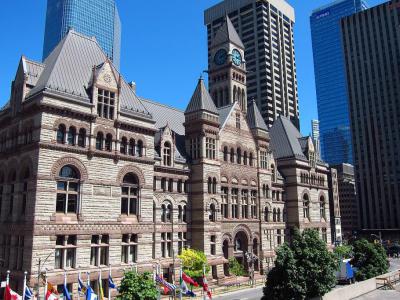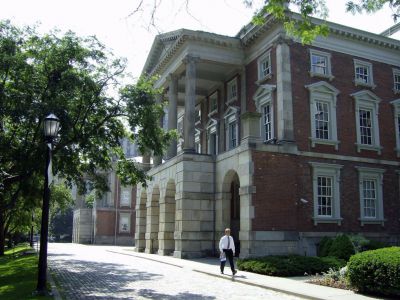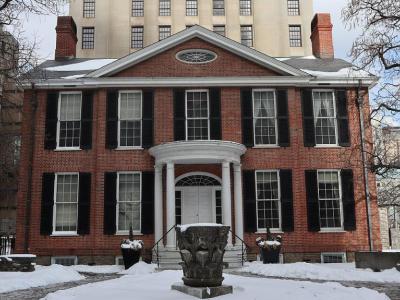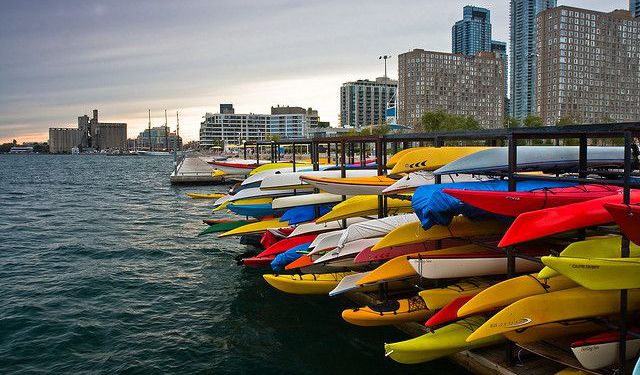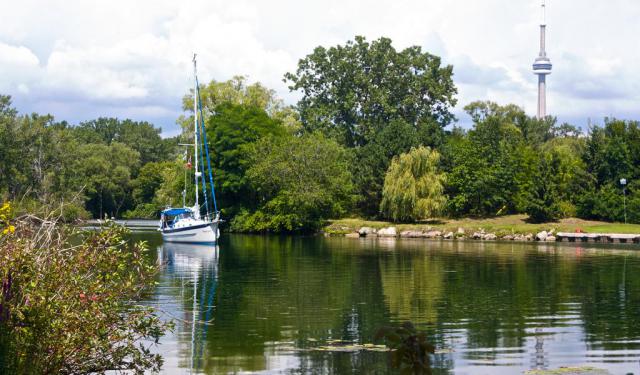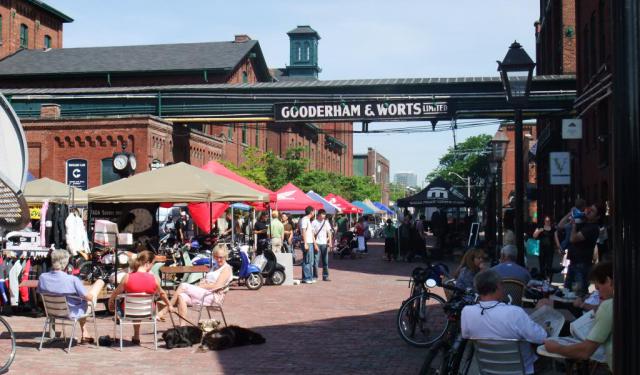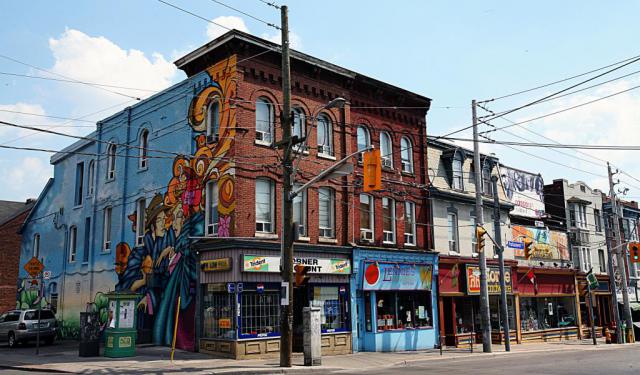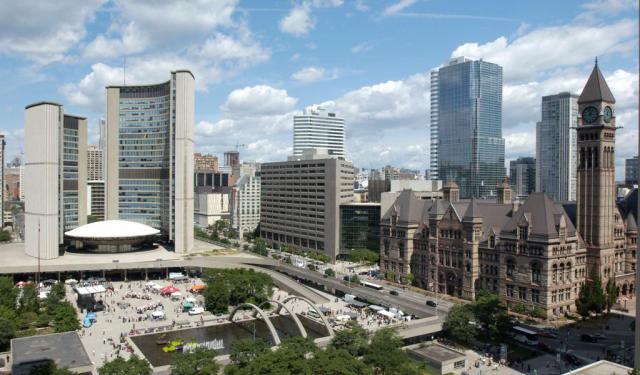Historical Buildings Walking Tour (Self Guided), Toronto
Once an Anglo backwater, today's Toronto is the cultural and economic hub of English-speaking Canada. The city's architectural beauty is supplemented by its historical richness, with some of the buildings dating back as far as the late 18th century. This self-guided tour invites you to explore the most prominent structures making up the historic heritage of Toronto.
The Gooderham Building, also known as the Flatiron Building, stands as an iconic triangular-shaped structure in the heart of the city. Built in 1892, it's a testament to Toronto's architectural diversity and innovation.
The Daniel Brooke Building, constructed in 1833, is another architectural gem, standing out in the city's landscape with its Georgian-style elegance.
Saint Lawrence Hall, a marvelous Renaissance Revival edifice erected in 1850, has witnessed significant events in Toronto's history. It once served as a public meeting place and cultural hub. Similarly, the Massey Hall, an iconic concert venue, has hosted legendary musicians and cultural events since 1894.
Saint James Anglican Cathedral, dating back to 1853, is an exquisite example of Gothic Revival. Its soaring spire makes it a hard-to-miss landmark for architecture enthusiasts. Another prominent piece of ecclesiastical masonry from the same period, Saint Michael's Cathedral, built in 1848, is an elegant Catholic temple featuring stunning stained glass windows and a majestic interior.
Mackenzie House, the former home of Toronto's first mayor, William Lyon Mackenzie, offers a glimpse into 19th-century life in the city. In the same vein, the Campbell House Museum, a Georgian-style mansion built in 1822, allows visitors to step back in time and explore Toronto's early history.
On the other hand, the grand Romanesque Old City Hall, completed in 1899, and the Osgoode Hall, with its mixed (Neoclassical, Georgian, and Palladian) architecture from the 1830s, exemplify office buildings of that era. The former once served as Toronto's city hall, while the latter still houses the Ontario Court of Appeal and the Law Society of Ontario.
These historical buildings collectively tell the story of Toronto's evolution and provide a good vehicle for those willing to connect with the past. If you're visiting Toronto or live in the area, you might be interested in exploring these remarkable sites in more detail and thus appreciate the cultural tapestry that makes this city so special.
The Gooderham Building, also known as the Flatiron Building, stands as an iconic triangular-shaped structure in the heart of the city. Built in 1892, it's a testament to Toronto's architectural diversity and innovation.
The Daniel Brooke Building, constructed in 1833, is another architectural gem, standing out in the city's landscape with its Georgian-style elegance.
Saint Lawrence Hall, a marvelous Renaissance Revival edifice erected in 1850, has witnessed significant events in Toronto's history. It once served as a public meeting place and cultural hub. Similarly, the Massey Hall, an iconic concert venue, has hosted legendary musicians and cultural events since 1894.
Saint James Anglican Cathedral, dating back to 1853, is an exquisite example of Gothic Revival. Its soaring spire makes it a hard-to-miss landmark for architecture enthusiasts. Another prominent piece of ecclesiastical masonry from the same period, Saint Michael's Cathedral, built in 1848, is an elegant Catholic temple featuring stunning stained glass windows and a majestic interior.
Mackenzie House, the former home of Toronto's first mayor, William Lyon Mackenzie, offers a glimpse into 19th-century life in the city. In the same vein, the Campbell House Museum, a Georgian-style mansion built in 1822, allows visitors to step back in time and explore Toronto's early history.
On the other hand, the grand Romanesque Old City Hall, completed in 1899, and the Osgoode Hall, with its mixed (Neoclassical, Georgian, and Palladian) architecture from the 1830s, exemplify office buildings of that era. The former once served as Toronto's city hall, while the latter still houses the Ontario Court of Appeal and the Law Society of Ontario.
These historical buildings collectively tell the story of Toronto's evolution and provide a good vehicle for those willing to connect with the past. If you're visiting Toronto or live in the area, you might be interested in exploring these remarkable sites in more detail and thus appreciate the cultural tapestry that makes this city so special.
How it works: Download the app "GPSmyCity: Walks in 1K+ Cities" from Apple App Store or Google Play Store to your mobile phone or tablet. The app turns your mobile device into a personal tour guide and its built-in GPS navigation functions guide you from one tour stop to next. The app works offline, so no data plan is needed when traveling abroad.
Historical Buildings Walking Tour Map
Guide Name: Historical Buildings Walking Tour
Guide Location: Canada » Toronto (See other walking tours in Toronto)
Guide Type: Self-guided Walking Tour (Sightseeing)
# of Attractions: 10
Tour Duration: 2 Hour(s)
Travel Distance: 2.6 Km or 1.6 Miles
Author: DanaOffice
Sight(s) Featured in This Guide:
Guide Location: Canada » Toronto (See other walking tours in Toronto)
Guide Type: Self-guided Walking Tour (Sightseeing)
# of Attractions: 10
Tour Duration: 2 Hour(s)
Travel Distance: 2.6 Km or 1.6 Miles
Author: DanaOffice
Sight(s) Featured in This Guide:
- Gooderham Building
- Daniel Brooke Building
- St. Lawrence Hall
- St. James Anglican Cathedral
- St. Michael's Cathedral
- Mackenzie House
- Massey Hall
- Old City Hall
- Osgoode Hall
- Campbell House Museum
1) Gooderham Building
Among the many places worth visiting in the Saint Lawrence neighborhood, especially for an architecture buff, is the Gooderham Building. Hardly five stories tall, wedged in a triangular intersection between Front and Wellington streets, this structure is one of the most photographed sights in the city. The house was built in 1892, ten years before its famous kin, the Fuller Building in New York City, and as such, represents an early example of the flatiron form of architecture.
The previous building on this site was shorter but of the same shape and was called the Coffin Block. The current vermilion red-brick edifice, with tinges of Romanesque styling, was constructed for distiller George Gooderham and served as the office of the Gooderham & Worts distillery until 1952. The Gooderham family sold the property in 1957, following which it changed hands several times. In 1975, the building was designated a historic site under the Ontario Heritage Act.
Besides its shape, the Gooderham Building is well-known for the mural on its back wall. The Flatiron Mural – created by renowned Canadian artist Derek Michael Besant – uses a trompe-l'œil effect to make the wall appear to have more windows than it does, as well as to give it a more mobile effect with the help of a picture of the Perkins Building, which is located directly across the street, depicted as if loosely 'tacked' down to the wall, with some of its edges 'fluttering' away.
Right behind the Gooderham Building is a tree-lined spot called Berczy Park. This park, housing a sizeable three-tier fountain fitted with 27 cast-iron dogs spouting water, a cast-iron cat, and crowned with a bone, was completed in 2017. The drinking trough for dogs has made this fountain a popular destination, particularly for dog lovers.
The previous building on this site was shorter but of the same shape and was called the Coffin Block. The current vermilion red-brick edifice, with tinges of Romanesque styling, was constructed for distiller George Gooderham and served as the office of the Gooderham & Worts distillery until 1952. The Gooderham family sold the property in 1957, following which it changed hands several times. In 1975, the building was designated a historic site under the Ontario Heritage Act.
Besides its shape, the Gooderham Building is well-known for the mural on its back wall. The Flatiron Mural – created by renowned Canadian artist Derek Michael Besant – uses a trompe-l'œil effect to make the wall appear to have more windows than it does, as well as to give it a more mobile effect with the help of a picture of the Perkins Building, which is located directly across the street, depicted as if loosely 'tacked' down to the wall, with some of its edges 'fluttering' away.
Right behind the Gooderham Building is a tree-lined spot called Berczy Park. This park, housing a sizeable three-tier fountain fitted with 27 cast-iron dogs spouting water, a cast-iron cat, and crowned with a bone, was completed in 2017. The drinking trough for dogs has made this fountain a popular destination, particularly for dog lovers.
2) Daniel Brooke Building
One of the very few structures that escaped the devastating fire of 1849 is the Daniel Brooke Building on Jarvis and King Street. Now standing in all its glory and wisdom, this antique edifice, built in 1833, was originally owned by Daniel Brooke, a wealthy local merchant.
Boasting elegant Georgian style, the architecture is quite a rare sight in the city. Throughout the years, the building has served as home to an array of commercial enterprises. In fact, it was also the place where James Austin and Patrick Foy first opened their grocery store. The former later went on to become one of the most prominent business figures in 19th century Canada. Subsequently, the building saw many prominent personalities and grew quite popular in the local business circuits. However, towards the end of the 19th century, the entire neighborhood surrounding the complex went into a spell of extreme poverty leading to the ultimate abandonment of the building.
Eventually, the government took it up to renovate and revamp the entire neighborhood, as well as to give the Daniel Brook Building the much needed face-lift. After tireless efforts, the area returned to its former glory and today is, once again, one of the trendiest neighborhoods in the city.
Boasting elegant Georgian style, the architecture is quite a rare sight in the city. Throughout the years, the building has served as home to an array of commercial enterprises. In fact, it was also the place where James Austin and Patrick Foy first opened their grocery store. The former later went on to become one of the most prominent business figures in 19th century Canada. Subsequently, the building saw many prominent personalities and grew quite popular in the local business circuits. However, towards the end of the 19th century, the entire neighborhood surrounding the complex went into a spell of extreme poverty leading to the ultimate abandonment of the building.
Eventually, the government took it up to renovate and revamp the entire neighborhood, as well as to give the Daniel Brook Building the much needed face-lift. After tireless efforts, the area returned to its former glory and today is, once again, one of the trendiest neighborhoods in the city.
3) St. Lawrence Hall
Standing elegantly close to the Saint Lawrence Market is a building fit to put any other structure in the vicinity to shame. Such is the grandeur and immense presence of the Saint Lawrence Hall. This spectacular building took shape in the mid-19th century and was the work of the renowned Anglo-Canadian architect, William Thomas. Thomas first moved to Canada with his wife and 10 children in 1837 to escape economic hardship in his native England. Thomas's career took off no sooner than he set foot in Toronto and he is now considered to be one of the most gifted architects of his time.
The Saint Lawrence Hall is believed to be one of William Thomas’s best works. Designed in Renaissance Revival style, this colossal building has a fantastic facade that complements its width. An interesting feature is the typical Roman temple that takes center stage atop this building.
The overall breathtaking view of the edifice makes it seemingly unlikely that any single element thereof can enchant you more. Still, the interiors of Saint Lawrence manage to achieve exactly that, displaying elegance, sophistication and opulence. No wonder, the Hall has been the epitome of Toronto’s artistic society.
The Saint Lawrence Hall is believed to be one of William Thomas’s best works. Designed in Renaissance Revival style, this colossal building has a fantastic facade that complements its width. An interesting feature is the typical Roman temple that takes center stage atop this building.
The overall breathtaking view of the edifice makes it seemingly unlikely that any single element thereof can enchant you more. Still, the interiors of Saint Lawrence manage to achieve exactly that, displaying elegance, sophistication and opulence. No wonder, the Hall has been the epitome of Toronto’s artistic society.
4) St. James Anglican Cathedral
One of the most enthralling churches of Toronto is the Saint James Cathedral. Not only does the facade of this church make it captivating, but it is also the story that accompanies it.
Home to the oldest congregation in Toronto, established in 1797, Saint James's serves as the spiritual center of Saint Lawrence neighborhood and is the episcopal seat of the Anglican Church of Canada's Diocese of Toronto. All of this makes it one of the most treasured heritage sites in the city.
Built in the mid-19th century, the cathedral boasts a magnificent Gothic Revival style of architecture. Designed by Frederick William Cumberland, the Saint James Cathedral greets spectators from far and wide coming to admire its sheer beauty. The structure flaunts a wonderful harmony of proportions and grandeur. With its white brick and sandstone exterior, the building conspicuously stands out in contrast to its surrounding landscape. Along with its exteriors, the cathedral's insides are also equally breathtaking. The architectural elements include high raised ceiling, ribbed vaults and pointed arched lights that brighten the interiors with natural illumination, making it a truly magnificent sight to behold during daylight.
Home to the oldest congregation in Toronto, established in 1797, Saint James's serves as the spiritual center of Saint Lawrence neighborhood and is the episcopal seat of the Anglican Church of Canada's Diocese of Toronto. All of this makes it one of the most treasured heritage sites in the city.
Built in the mid-19th century, the cathedral boasts a magnificent Gothic Revival style of architecture. Designed by Frederick William Cumberland, the Saint James Cathedral greets spectators from far and wide coming to admire its sheer beauty. The structure flaunts a wonderful harmony of proportions and grandeur. With its white brick and sandstone exterior, the building conspicuously stands out in contrast to its surrounding landscape. Along with its exteriors, the cathedral's insides are also equally breathtaking. The architectural elements include high raised ceiling, ribbed vaults and pointed arched lights that brighten the interiors with natural illumination, making it a truly magnificent sight to behold during daylight.
5) St. Michael's Cathedral
On Church Street in the Garden District of Toronto stands Saint Michael’s Cathedral. Clad in tones of grey and brick, this cathedral stands solitary with its exceptional majestic appeal and timeless architectural pride. And why not, Saint Michael's is the oldest temple in Toronto, dating back to the mid-19th century.
This overpowering structure demands attention of any passer-by with its robust Neo-Gothic appearance and linear, geometric patterns. Although its exterior may be quite overwhelming and severe, the interior of the cathedral comes as a total surprise. Balancing the exacting exterior, the insides of the church are dabbed with color, grandeur and gentle elegance. Unlike many Christian places of worship in Toronto, built in Gothic Revival (where the Gothic is tweaked to fit modern times), Saint Michael's Cathedral sticks to the classic Gothic style – featuring rich stained glass windows, high vaulted ceiling with richly hued murals and paintings along with sculptures of various saints and other figurines. The cathedral was designed by William Thomas, an Anglo-Canadian architect, best known for his stunning and timeless creations and vintage architectural landscape in Canada.
Other than being a place of faith for the Catholics of the region, this cathedral was heavily involved in the establishment of the Saint Michael’s Hospital, a medical center and a teaching hospital in Toronto.
Why You Should Visit:
Beautiful architecture, magnificent in terms of colors and comfort.
After an extensive renovation, the basement is now functional, the pews are all cushioned and the solemnity of the place is well kept!
Tip:
This is a great place to attend mass, especially when the Saint Michael's choir is singing.
This overpowering structure demands attention of any passer-by with its robust Neo-Gothic appearance and linear, geometric patterns. Although its exterior may be quite overwhelming and severe, the interior of the cathedral comes as a total surprise. Balancing the exacting exterior, the insides of the church are dabbed with color, grandeur and gentle elegance. Unlike many Christian places of worship in Toronto, built in Gothic Revival (where the Gothic is tweaked to fit modern times), Saint Michael's Cathedral sticks to the classic Gothic style – featuring rich stained glass windows, high vaulted ceiling with richly hued murals and paintings along with sculptures of various saints and other figurines. The cathedral was designed by William Thomas, an Anglo-Canadian architect, best known for his stunning and timeless creations and vintage architectural landscape in Canada.
Other than being a place of faith for the Catholics of the region, this cathedral was heavily involved in the establishment of the Saint Michael’s Hospital, a medical center and a teaching hospital in Toronto.
Why You Should Visit:
Beautiful architecture, magnificent in terms of colors and comfort.
After an extensive renovation, the basement is now functional, the pews are all cushioned and the solemnity of the place is well kept!
Tip:
This is a great place to attend mass, especially when the Saint Michael's choir is singing.
6) Mackenzie House
The Mackenzie House, located on Bond Street, is a remarkable gas-lit Georgian-style row house constructed in the 1850s. Legend has it that this historical residence is haunted by the ghost of William Lyon Mackenzie, the first mayor of Toronto. Mackenzie, who migrated from Scotland in 1820, established his political newspaper, "Colonial Advocate," within these walls.
Originally, the house served as a print shop, where Mackenzie produced his publications. He resided here with his wife Isabel and their 13 children until his passing in 1861, which occurred in the second-floor bedroom. In the 1930s, the property faced the threat of demolition until concerned citizens rallied together and raised enough funds to save it.
Thanks to their efforts, the Mackenzie House was spared. In 1950, the Toronto Historical Board undertook a comprehensive renovation and restoration project, transforming the house into a museum that offers visitors a glimpse into Victorian-era life. The museum is now managed by the Cultural Division of Toronto City and Museum and Heritage Services.
During a period of a prolonged closure, the Mackenzie House became the subject of numerous reports detailing strange occurrences, fueling beliefs in its haunting. Witnesses claimed to have seen a figure matching Mackenzie's description, as well as a woman with long hair, even when the house was empty and securely locked.
Other paranormal phenomena included the eerie sound of an antique piano playing, the faint echoes of a printing press in operation, and mysterious footsteps. Although these supernatural activities have been witnessed and reported, they have yet to be fully documented. Whether for the thrill of history or the allure of mystery, a visit to the Mackenzie House is an absolute must.
Originally, the house served as a print shop, where Mackenzie produced his publications. He resided here with his wife Isabel and their 13 children until his passing in 1861, which occurred in the second-floor bedroom. In the 1930s, the property faced the threat of demolition until concerned citizens rallied together and raised enough funds to save it.
Thanks to their efforts, the Mackenzie House was spared. In 1950, the Toronto Historical Board undertook a comprehensive renovation and restoration project, transforming the house into a museum that offers visitors a glimpse into Victorian-era life. The museum is now managed by the Cultural Division of Toronto City and Museum and Heritage Services.
During a period of a prolonged closure, the Mackenzie House became the subject of numerous reports detailing strange occurrences, fueling beliefs in its haunting. Witnesses claimed to have seen a figure matching Mackenzie's description, as well as a woman with long hair, even when the house was empty and securely locked.
Other paranormal phenomena included the eerie sound of an antique piano playing, the faint echoes of a printing press in operation, and mysterious footsteps. Although these supernatural activities have been witnessed and reported, they have yet to be fully documented. Whether for the thrill of history or the allure of mystery, a visit to the Mackenzie House is an absolute must.
7) Massey Hall
Located in Toronto, the Massey Hall is a remarkable venue that offers a diverse range of artistic expressions, encompassing classical music, jazz, and captivating international dance troupes. Generously bestowed upon the city by the Massey family, this architectural masterpiece was designed by Canadian architect Sidney Badgley. Hosting over 100 events each year, the hall boasts a seating capacity of 2,765 individuals across two balconies and a ground floor.
In its inaugural concert back in 1894, the venue showcased Handel's Messiah, marking the beginning of its illustrious history. Throughout the years, esteemed artists such as Charlie Parker, Dizzy Gillespie, Mark Knopfler, Buddy Guy, and Bob Marley, among many others, have graced its stage, drawn to the hall's awe-inspiring acoustics.
Notably, the renowned Canadian songwriter Neil Young immortalized his "Live at Massey Hall" performance with a recording released in 1971. That very same year, the hall attained the distinction of being a site of National Historic importance in Canada. Further recognition came in 1975 when the Toronto City Council designated it as a "Heritage Property" under the Ontario Heritage Act.
Before a concert, patrons can indulge in a delightful pre-show experience at Centuries, the hall's Victorian-style bar and lounge, adorned with cherished memories of all the artists who have enchanted audiences at Massey Hall.
Operating as a non-profit charitable organization, the Corporation of Massey Hall stands as a steadfast pillar of support for nurturing the talents of Canadians, dedicated to providing a platform for showcasing international arts.
In its inaugural concert back in 1894, the venue showcased Handel's Messiah, marking the beginning of its illustrious history. Throughout the years, esteemed artists such as Charlie Parker, Dizzy Gillespie, Mark Knopfler, Buddy Guy, and Bob Marley, among many others, have graced its stage, drawn to the hall's awe-inspiring acoustics.
Notably, the renowned Canadian songwriter Neil Young immortalized his "Live at Massey Hall" performance with a recording released in 1971. That very same year, the hall attained the distinction of being a site of National Historic importance in Canada. Further recognition came in 1975 when the Toronto City Council designated it as a "Heritage Property" under the Ontario Heritage Act.
Before a concert, patrons can indulge in a delightful pre-show experience at Centuries, the hall's Victorian-style bar and lounge, adorned with cherished memories of all the artists who have enchanted audiences at Massey Hall.
Operating as a non-profit charitable organization, the Corporation of Massey Hall stands as a steadfast pillar of support for nurturing the talents of Canadians, dedicated to providing a platform for showcasing international arts.
8) Old City Hall
Located at the intersection of Queen and Bay Streets in Downtown Toronto stands an impressive building with Romanesque-style architecture. This remarkable structure, known today as the Old City Hall, served as the Toronto City Council's home from 1899 to 1966, becoming the third city hall constructed for the flourishing city. Upon its completion, it ranked among the largest buildings in Toronto and stood as the largest civic edifice in North America.
Renowned architect Edward James Lennox led the creation of this masterpiece. Over a decade of construction, the majestic City Hall emerged as an iconic landmark. Its remarkable clock tower, standing at 103.6 meters (340 feet), became the city's crown jewel. The clock mechanism was crafted in Croydon, England. Inside the clock room, three bells were placed: two smaller ones that chimed every quarter hour, and a bourdon bell weighing 5,443 kilograms, which tolled every hour.
Matching the splendid exterior, the interior of the building exuded charm, adorned with intricate details. Noteworthy features include a grand staircase adorned with stained glass windows depicting Canadian history, various murals, statues, and other decorative elements.
Despite its grandeur, the Old City Hall proved inadequate for Toronto's expanding municipal government within a few decades of its construction. In the 1960s, plans were made to demolish the building and make way for a retail complex known as the Eaton Centre. However, thanks to public outcry, the Old City Hall was saved and repurposed as a courthouse. In 1984, it received the prestigious designation as a National Historic Site, preserving its historical significance for future generations.
Tip:
Make sure to visit the small "lake" close by, as many of the pictures from Toronto you might know are taken from this place while facing the "TORONTO" sign.
Renowned architect Edward James Lennox led the creation of this masterpiece. Over a decade of construction, the majestic City Hall emerged as an iconic landmark. Its remarkable clock tower, standing at 103.6 meters (340 feet), became the city's crown jewel. The clock mechanism was crafted in Croydon, England. Inside the clock room, three bells were placed: two smaller ones that chimed every quarter hour, and a bourdon bell weighing 5,443 kilograms, which tolled every hour.
Matching the splendid exterior, the interior of the building exuded charm, adorned with intricate details. Noteworthy features include a grand staircase adorned with stained glass windows depicting Canadian history, various murals, statues, and other decorative elements.
Despite its grandeur, the Old City Hall proved inadequate for Toronto's expanding municipal government within a few decades of its construction. In the 1960s, plans were made to demolish the building and make way for a retail complex known as the Eaton Centre. However, thanks to public outcry, the Old City Hall was saved and repurposed as a courthouse. In 1984, it received the prestigious designation as a National Historic Site, preserving its historical significance for future generations.
Tip:
Make sure to visit the small "lake" close by, as many of the pictures from Toronto you might know are taken from this place while facing the "TORONTO" sign.
9) Osgoode Hall
Toronto's Osgoode Hall is a remarkable heritage building sprawling across six acres. It has captivated attention for 170 years as a hub of legal activity and was aptly named after William Osgoode, the first Chief Justice of the province. Construction on this historic structure commenced in 1829, but it took a span of 20 years and the expertise of multiple architects, including John Ewart and W.W. Baldwin, to complete.
The exterior facade proudly showcases the exquisite Italian Renaissance style, while the interior boasts an array of stunning features, such as stained glass heraldic windows, intricate ceilings, and graceful arched pillars. Elements of the Palladian architectural style can also be admired within the Hall.
Following a period of use as troop barracks from 1838 to 1843, Osgoode Hall underwent a series of restoration projects between 1844 and 1891. Until the relocation of York University's faculty in 1969, the Hall served as the prestigious home of the Osgoode Hall Law School, a renowned institution for legal education.
In 1928, to honor Ontario lawyers and law students who had lost their lives during the First World War, a memorial sculpted by Frances Norma Loring was added to the Hall's Library. In recognition of its historical significance, Osgoode Hall was officially designated a National Historic Site of Canada in 1979.
Presently, Osgoode Hall accommodates the Law Society of Upper Canada, the Superior Court of Justice, and the Ontario Court of Appeal, solidifying its enduring role as a vital center for the legal community.
The exterior facade proudly showcases the exquisite Italian Renaissance style, while the interior boasts an array of stunning features, such as stained glass heraldic windows, intricate ceilings, and graceful arched pillars. Elements of the Palladian architectural style can also be admired within the Hall.
Following a period of use as troop barracks from 1838 to 1843, Osgoode Hall underwent a series of restoration projects between 1844 and 1891. Until the relocation of York University's faculty in 1969, the Hall served as the prestigious home of the Osgoode Hall Law School, a renowned institution for legal education.
In 1928, to honor Ontario lawyers and law students who had lost their lives during the First World War, a memorial sculpted by Frances Norma Loring was added to the Hall's Library. In recognition of its historical significance, Osgoode Hall was officially designated a National Historic Site of Canada in 1979.
Presently, Osgoode Hall accommodates the Law Society of Upper Canada, the Superior Court of Justice, and the Ontario Court of Appeal, solidifying its enduring role as a vital center for the legal community.
10) Campbell House Museum
Built by the Sixth Chief Justice of Upper Canada, Sir William Campbell, and his wife in 1822, the Campbell House is the oldest remaining house from the original city of York in Toronto. Lady Campbell inherited this Georgian-style house after the death of William Campbell in 1834. All contents of the house were auctioned after her death and until 1890 it served as a residence for local notables.
Originally, the house was on Adelaide Street East and after 150 years, the 300-ton house was shifted to University Avenue with an assistance from the Toronto Transit Commission. A campaign was launched by the Advocates Society to save the house when its last owners, Coutts-Hallmark Greeting Cards Company, decided to demolish it in 1972. On April 1st 1972, the house was fully restored and opened by Her Majesty Queen Elizabeth.
Designed for comfort and entertainment, the House was constructed when the Campbells were socially and economically established. After the Campbells, it was used by a horseshoe nails company and elevator company as an office and factory, respectively. Today, the house operates as a museum that educates both tourists and locals about the lifestyles, trends and tit-bits from the bygone era. Visitors are offered guided tours of the property and can enjoy educational programs like historic baking, Scottish dancing, storytelling, etc. It also serves as a club for the members of Advocates Society.
Originally, the house was on Adelaide Street East and after 150 years, the 300-ton house was shifted to University Avenue with an assistance from the Toronto Transit Commission. A campaign was launched by the Advocates Society to save the house when its last owners, Coutts-Hallmark Greeting Cards Company, decided to demolish it in 1972. On April 1st 1972, the house was fully restored and opened by Her Majesty Queen Elizabeth.
Designed for comfort and entertainment, the House was constructed when the Campbells were socially and economically established. After the Campbells, it was used by a horseshoe nails company and elevator company as an office and factory, respectively. Today, the house operates as a museum that educates both tourists and locals about the lifestyles, trends and tit-bits from the bygone era. Visitors are offered guided tours of the property and can enjoy educational programs like historic baking, Scottish dancing, storytelling, etc. It also serves as a club for the members of Advocates Society.
Walking Tours in Toronto, Canada
Create Your Own Walk in Toronto
Creating your own self-guided walk in Toronto is easy and fun. Choose the city attractions that you want to see and a walk route map will be created just for you. You can even set your hotel as the start point of the walk.
Toronto's Waterfront Walking Tour
It is more than obvious that the locals of Toronto, as well as visitors, cherish and admire the alluring views of Lake Ontario on the shores of which the city is located. Toronto's waterfront is one of the most picturesque places for walking, but it is also a great destination for those in search of entertainment.
At the heart of this waterfront area stands Queen's Quay Terminal, a... view more
Tour Duration: 2 Hour(s)
Travel Distance: 3.7 Km or 2.3 Miles
At the heart of this waterfront area stands Queen's Quay Terminal, a... view more
Tour Duration: 2 Hour(s)
Travel Distance: 3.7 Km or 2.3 Miles
Toronto Islands Walking Tour
The Toronto Islands, otherwise simply known as “the Islands,” are a chain of islands in Lake Ontario, just off the coast of downtown Toronto. They include three major islands (namely: Centre Island, Algonquin or Sunfish Island, and Olympic Island) and several smaller ones. Collectively they are a great natural retreat set in a peaceful and joyful environment, which, apart from the panoramic... view more
Tour Duration: 2 Hour(s)
Travel Distance: 3.3 Km or 2.1 Miles
Tour Duration: 2 Hour(s)
Travel Distance: 3.3 Km or 2.1 Miles
Distillery District Walking Tour
Toronto's Distillery District is a trendy neighborhood and an architectural treasure dating back to 1859. Once the largest distillery in the British Empire, today this former industrial complex is a National Historic Site of Canada and a unique pocket of Victorian-era architecture, featuring the continent's best-preserved collection of cobblestone pathways and historic buildings housing... view more
Tour Duration: 1 Hour(s)
Travel Distance: 0.8 Km or 0.5 Miles
Tour Duration: 1 Hour(s)
Travel Distance: 0.8 Km or 0.5 Miles
Cabbagetown Walking Tour
Once a small community of Irish immigrants east of downtown and one of the poorest neighborhoods in Toronto, Cabbagetown is also one of the city's oldest districts, established in 1840. In 2004, it was declared a historic district and presently claims to be "the largest continuous area of preserved Victorian housing in North America". Attesting to this claim are the picturesque... view more
Tour Duration: 1 Hour(s)
Travel Distance: 1.8 Km or 1.1 Miles
Tour Duration: 1 Hour(s)
Travel Distance: 1.8 Km or 1.1 Miles
Toronto Introduction Walking Tour
Sprawling on the northwestern shore of Lake Ontario, the capital of the Canadian province of Ontario, Toronto, is a major metropolis renowned for its dynamic pace and high-rising skyline, incorporating both ultra-modern skyscrapers and historic architecture.
The area of present-day Toronto has been inhabited for thousands of years. Its first known settlers – the Wyandot (or Huron) people –... view more
Tour Duration: 2 Hour(s)
Travel Distance: 3.9 Km or 2.4 Miles
The area of present-day Toronto has been inhabited for thousands of years. Its first known settlers – the Wyandot (or Huron) people –... view more
Tour Duration: 2 Hour(s)
Travel Distance: 3.9 Km or 2.4 Miles
Useful Travel Guides for Planning Your Trip
The Epic Toronto Pub Crawl
There is no better way to see Toronto’s many different neighborhoods and get a literal taste of the Distillery District, the Esplanade, downtown, the Entertainment District and Yorkville. Plus you’ll learn a little about the bar and get its highlights at your fingertips so you’ll be in the...
Traveler's Guide to Toronto: 14 Authentic Canadian Products to Bring Home
Toronto may well not be the whole Canada, but no Canada is whole without Toronto! By far too many things, quintessentially Canadian, associate with this bustling city, from Niagara Falls to Ice Hockey to... to mention but a few. To mention them all, check out the list of some not-to-be-missed...
The Most Popular Cities
/ view all
